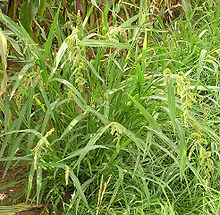Echinochloa
| barnyard grass cockspur grass |
|
|---|---|
 |
|
|
common barnyard grass (Echinochloa crus-galli) |
|
| Scientific classification | |
| Kingdom: | Plantae |
| (unranked): | Angiosperms |
| (unranked): | Monocots |
| (unranked): | Commelinids |
| Order: | Poales |
| Family: | Poaceae |
| Subfamily: | Panicoideae |
| Tribe: | Paniceae |
| Genus: |
Echinochloa P.Beauv. |
| Type species | |
|
Echinochloa crus-galli (L.) P.Beauv. |
|
| Synonyms | |
|
|
Echinochloa is a very widespread genus of plants in the grass family. Some of the species are known by the common names barnyard grass or cockspur grass.
Some of whose members of the genus are millets grown as cereal or fodder crops. The most notable of these are Japanese millet (E. esculenta) in East Asia, Indian barnyard millet (E. frumentacea) in South Asia, and burgu millet (E. stagnina) in West Africa. Collectively, the members of this genus are called barnyard grasses (though this may also refer to E. crus-galli specifically), barnyard millets or billion-dollar grasses.
When not grown on purpose, these grasses may become a nuisance to farmers. In particular, common barnyard grass (E. crus-galli) is notorious as a weed. It is not easily suppressed with living mulches such as velvet bean (Mucuna pruriens var. utilis).Early barnyard grass (E. oryzoides) is a well-known example of Vavilovian mimicry: the plants have evolved to resemble rice (Oryza), enabling them to escape weeding more easily.
Among the plant pathogens that affect this genus are the sac fungus Cochliobolus sativus, which has been noted on common barnyard grass, and rice hoja blanca virus. Both affect many other grass species, in particular most important cereals, and Echinochloa weeds may serve as a reservoir. The fungi Drechslera monoceras and Exserohilum monoceras have been evaluated with some success as potential biocontrol agents of common barnyard grass in rice fields. More research is necessary, however, because they may not be host-specific enough to be of practical use.
...
Wikipedia
